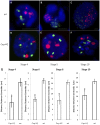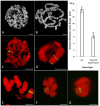Condensin II promotes the formation of chromosome territories by inducing axial compaction of polyploid interphase chromosomes
- PMID: 22956908
- PMCID: PMC3431300
- DOI: 10.1371/journal.pgen.1002873
Condensin II promotes the formation of chromosome territories by inducing axial compaction of polyploid interphase chromosomes
Abstract
The eukaryotic nucleus is both spatially and functionally partitioned. This organization contributes to the maintenance, expression, and transmission of genetic information. Though our ability to probe the physical structure of the genome within the nucleus has improved substantially in recent years, relatively little is known about the factors that regulate its organization or the mechanisms through which specific organizational states are achieved. Here, we show that Drosophila melanogaster Condensin II induces axial compaction of interphase chromosomes, globally disrupts interchromosomal interactions, and promotes the dispersal of peri-centric heterochromatin. These Condensin II activities compartmentalize the nucleus into discrete chromosome territories and indicate commonalities in the mechanisms that regulate the spatial structure of the genome during mitosis and interphase.
Conflict of interest statement
The authors have declared that no competing interests exist.
Figures






Similar articles
-
Chromosome territories meet a condensin.PLoS Genet. 2012;8(8):e1002939. doi: 10.1371/journal.pgen.1002939. Epub 2012 Aug 30. PLoS Genet. 2012. PMID: 22956917 Free PMC article. No abstract available.
-
Maintenance of interphase chromosome compaction and homolog pairing in Drosophila is regulated by the condensin cap-h2 and its partner Mrg15.Genetics. 2013 Sep;195(1):127-46. doi: 10.1534/genetics.113.153544. Epub 2013 Jul 2. Genetics. 2013. PMID: 23821596 Free PMC article.
-
Bivalent individualization during chromosome territory formation in Drosophila spermatocytes by controlled condensin II protein activity and additional force generators.PLoS Genet. 2021 Oct 20;17(10):e1009870. doi: 10.1371/journal.pgen.1009870. eCollection 2021 Oct. PLoS Genet. 2021. PMID: 34669718 Free PMC article.
-
SMC complexes orchestrate the mitotic chromatin interaction landscape.Curr Genet. 2018 Apr;64(2):335-339. doi: 10.1007/s00294-017-0755-y. Epub 2017 Sep 21. Curr Genet. 2018. PMID: 28936767 Free PMC article. Review.
-
Interphase chromatin biophysics and mechanics: new perspectives and open questions.Curr Opin Genet Dev. 2025 Feb;90:102296. doi: 10.1016/j.gde.2024.102296. Epub 2024 Dec 25. Curr Opin Genet Dev. 2025. PMID: 39724779 Review.
Cited by
-
3D Genome Organization: Causes and Consequences for DNA Damage and Repair.Genes (Basel). 2021 Dec 21;13(1):7. doi: 10.3390/genes13010007. Genes (Basel). 2021. PMID: 35052348 Free PMC article. Review.
-
Nesprin-2 Interacts with Condensin Component SMC2.Int J Cell Biol. 2017;2017:8607532. doi: 10.1155/2017/8607532. Epub 2017 Dec 27. Int J Cell Biol. 2017. PMID: 29445399 Free PMC article.
-
Formation of a nucleoplasmic reticulum requires de novo assembly of nascent phospholipids and shows preferential incorporation of nascent lamins.Sci Rep. 2017 Aug 7;7(1):7454. doi: 10.1038/s41598-017-07614-w. Sci Rep. 2017. PMID: 28785031 Free PMC article.
-
Statistical mechanics of chromosomes: in vivo and in silico approaches reveal high-level organization and structure arise exclusively through mechanical feedback between loop extruders and chromatin substrate properties.Nucleic Acids Res. 2020 Nov 18;48(20):11284-11303. doi: 10.1093/nar/gkaa871. Nucleic Acids Res. 2020. PMID: 33080019 Free PMC article.
-
Anchoring of Heterochromatin to the Nuclear Lamina Reinforces Dosage Compensation-Mediated Gene Repression.PLoS Genet. 2016 Sep 30;12(9):e1006341. doi: 10.1371/journal.pgen.1006341. eCollection 2016 Sep. PLoS Genet. 2016. PMID: 27690361 Free PMC article.
References
-
- Cremer T, Cremer M, Dietzel S, Muller S, Solovei I, et al. (2006) Chromosome territories–a functional nuclear landscape. Curr Opin Cell Biol 18: 307–16. - PubMed
-
- Goto B, Okazaki K, Niwa O (2001) Cytoplasmic microtubular system implicated in de novo formation of a Rabl-like orientation of chromosomes in fission yeast. J Cell Sci 114: 2427–35. - PubMed
-
- Pecinka A, Schubert V, Meister A, Kreth G, Klatte M, et al. (2004) Chromosome territory arrangement and homologous pairing in nuclei of Arabidopsis thaliana are predominantly random except for NOR-bearing chromosomes. Chromosoma 113: 258–69. - PubMed
Publication types
MeSH terms
Substances
Grants and funding
LinkOut - more resources
Full Text Sources
Molecular Biology Databases

